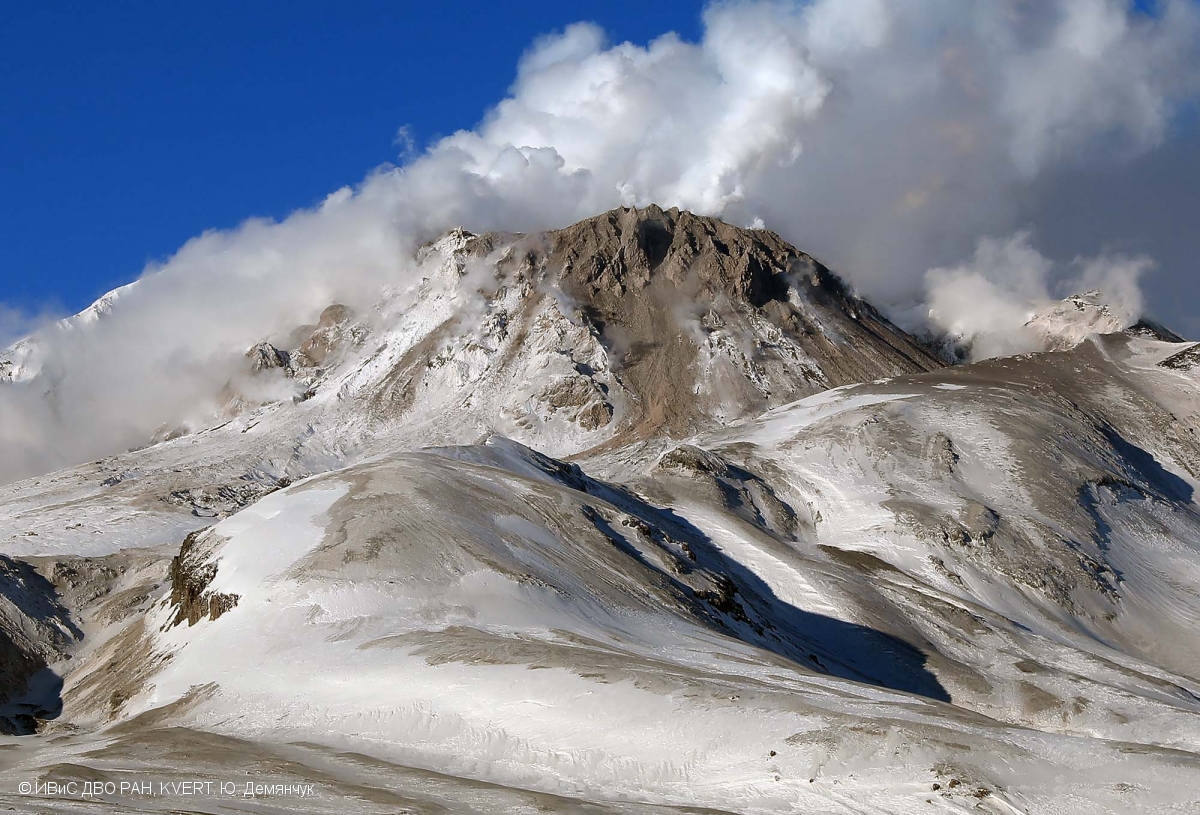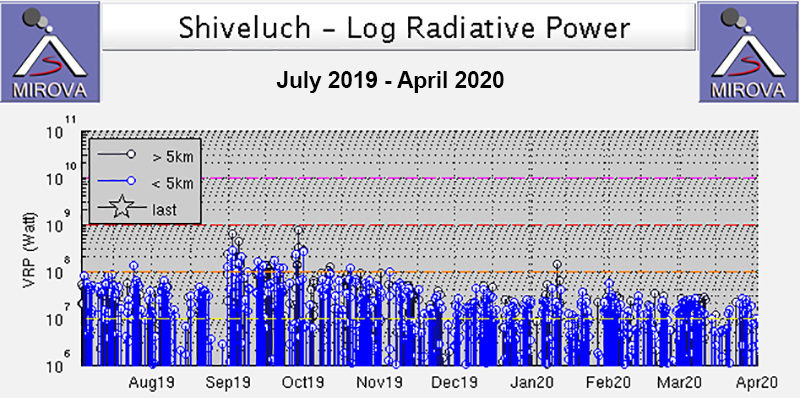Report on Sheveluch (Russia) — May 2020
Bulletin of the Global Volcanism Network, vol. 45, no. 5 (May 2020)
Managing Editor: Edward Venzke.
Research and preparation by Paul Berger.
Sheveluch (Russia) Lava dome growth and thermal anomalies continue through April 2020, but few ash explosions
Please cite this report as:
Global Volcanism Program, 2020. Report on Sheveluch (Russia) (Venzke, E., ed.). Bulletin of the Global Volcanism Network, 45:5. Smithsonian Institution. https://doi.org/10.5479/si.GVP.BGVN202005-300270
Sheveluch
Russia
56.653°N, 161.36°E; summit elev. 3283 m
All times are local (unless otherwise noted)
The eruption at Sheveluch has continued for more than 20 years, with strong explosions that have produced ash plumes, lava dome growth, hot avalanches, numerous thermal anomalies, and strong fumarolic activity (BGVN 44:05). During this time, there have been periods of greater or lesser activity. The most recent period of increased activity began in December 2018 and continued through October 2019 (BGVN 44:11). This report covers activity between November 2019 to April 2020, a period during which activity waned. The volcano is monitored by the Kamchatka Volcanic Eruptions Response Team (KVERT) and Tokyo Volcanic Ash Advisory Center (VAAC).
During the reporting period, KVERT noted that lava dome growth continued, accompanied by incandescence of the dome blocks and hot avalanches. Strong fumarolic activity was also present (figure 53). However, the overall eruption intensity waned. Ash plumes sometimes rose to 10 km altitude and drifted downwind over 600 km (table 14). The Aviation Color Code (ACC) remained at Orange (the second highest level on a four-color scale), except for 3 November when it was raised briefly to Red (the highest level).
 |
Figure 53. Fumarolic activity of Sheveluch’s lava dome on 24 January 2020. Photo by Y. Demyanchuk; courtesy of KVERT. |
Table 14. Explosions and ash plumes at Sheveluch during November 2019-April 2020. Dates and times are UTC, not local. Data courtesy of KVERT and the Tokyo VAAC.
| Dates | Plume Altitude (km) | Drift Distance and Direction | Remarks |
| 01-08 Nov 2019 | -- | 640 km NW | 3 November: ACC raised to Red from 0546-0718 UTC before returning to Orange. |
| 08-15 Nov 2019 | 9-10 | 1,300 km ESE | |
| 17-27 Dec 2019 | 6.0-6.5 | 25 km E | Explosions at about 23:50 UTC on 21 Dec. |
| 20-27 Mar 2020 | -- | 45 km N | 25 March: Gas-and-steam plume containing some ash. |
| 03-10 Apr 2020 | 10 km | 526 km SE | 8 April: Strong explosion at 1910 UTC. |
| 17-24 Apr 2020 | -- | 140 km NE | Re-suspended ash plume. |
KVERT reported thermal anomalies over the volcano every day, except for 25-26 January, when clouds obscured observations. During the reporting period, thermal anomalies, based on MODIS satellite instruments analyzed using the MODVOLC algorithm recorded hotspots on 10 days in November, 13 days in December, nine days in January, eight days in both February and March, and five days in April. The MIROVA (Middle InfraRed Observation of Volcanic Activity) volcano hotspot detection system, also based on analysis of MODIS data, detected numerous hotspots every month, almost all of which were of moderate radiative power (figure 54).
 |
Figure 54. Thermal anomalies at Sheveluch continued at elevated levels during November 2019-April 2020, as seen on this MIROVA Log Radiative Power graph for July 2019-April 2020. Courtesy of MIROVA. |
High sulfur dioxide levels were occasionally recorded just above or in the close vicinity of Sheveluch by the TROPOspheric Monitoring Instrument (TROPOMI) aboard the Copernicus Sentinel-5 Precursor satellite, but very little drift was observed.
Geological Summary. The high, isolated massif of Sheveluch volcano (also spelled Shiveluch) rises above the lowlands NNE of the Kliuchevskaya volcano group. The 1,300 km3 andesitic volcano is one of Kamchatka's largest and most active volcanic structures, with at least 60 large eruptions during the Holocene. The summit of roughly 65,000-year-old Stary Shiveluch is truncated by a broad 9-km-wide late-Pleistocene caldera breached to the south. Many lava domes occur on its outer flanks. The Molodoy Shiveluch lava dome complex was constructed during the Holocene within the large open caldera; Holocene lava dome extrusion also took place on the flanks of Stary Shiveluch. Widespread tephra layers from these eruptions have provided valuable time markers for dating volcanic events in Kamchatka. Frequent collapses of dome complexes, most recently in 1964, have produced debris avalanches whose deposits cover much of the floor of the breached caldera.
Information Contacts: Kamchatka Volcanic Eruptions Response Team (KVERT), Far Eastern Branch, Russian Academy of Sciences, 9 Piip Blvd., Petropavlovsk-Kamchatsky, 683006, Russia (URL: http://www.kscnet.ru/ivs/kvert/); Institute of Volcanology and Seismology, Far Eastern Branch, Russian Academy of Sciences (IVS FEB RAS), 9 Piip Blvd., Petropavlovsk-Kamchatsky 683006, Russia (URL: http://www.kscnet.ru/ivs/eng/); Tokyo Volcanic Ash Advisory Center (VAAC), 1-3-4 Otemachi, Chiyoda-ku, Tokyo, Japan (URL: http://ds.data.jma.go.jp/svd/vaac/data/); Hawai'i Institute of Geophysics and Planetology (HIGP) - MODVOLC Thermal Alerts System, School of Ocean and Earth Science and Technology (SOEST), Univ. of Hawai'i, 2525 Correa Road, Honolulu, HI 96822, USA (URL: http://modis.higp.hawaii.edu/); MIROVA (Middle InfraRed Observation of Volcanic Activity), a collaborative project between the Universities of Turin and Florence (Italy) supported by the Centre for Volcanic Risk of the Italian Civil Protection Department (URL: http://www.mirovaweb.it/); Sentinel Hub Playground (URL: https://www.sentinel-hub.com/explore/sentinel-playground); Global Sulfur Dioxide Monitoring Page, Atmospheric Chemistry and Dynamics Laboratory, NASA Goddard Space Flight Center (NASA/GSFC), 8800 Greenbelt Road, Goddard, Maryland, USA (URL: https://so2.gsfc.nasa.gov/).

